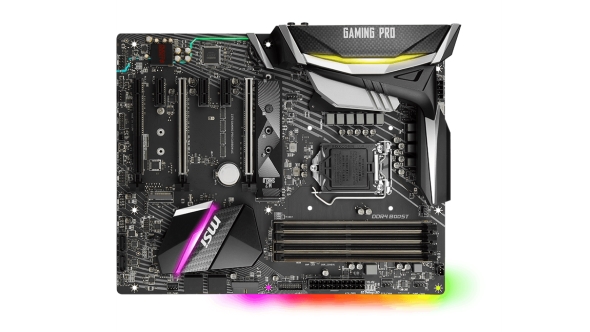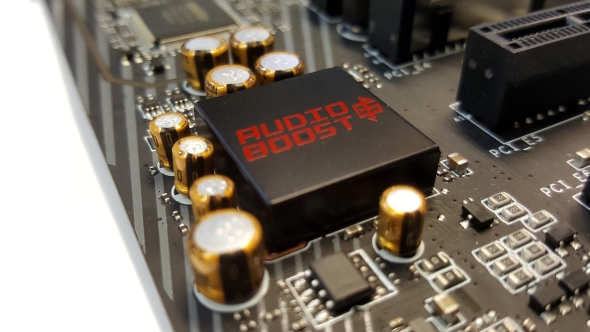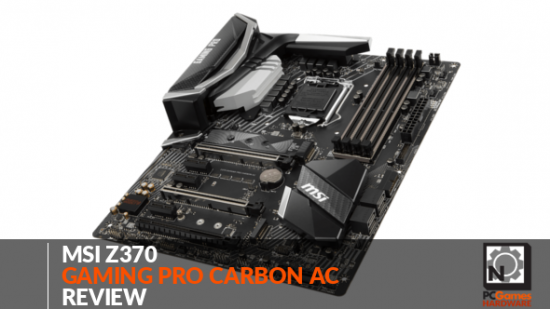Along with the new Intel Coffee Lake platform come the inevitable new motherboards. The MSI Z370 Gaming Pro Carbon AC is the first of these new boards to cross our test bench, and it’s a quality little mobo, but suffers against the competition because MSI are being good and playing by the book.
Read more: the best CPU for gaming.
I say ‘inevitable’ new motherboards, but given the Coffee Lake CPUs are more or less architecturally identical to the previous Skylake and Kaby Lake generations, it’s not beyond the realms of possibility to expect these new chips might have functioned in the existing Z270 platform. Not so. Because of the extra cores, and the extra power delivery needed, Intel have ring-fenced the latest processors, only allowing them to function in the new 300-series boards.
That’s great for the mobo manufacturers, allowing them to create a whole raft of new homes for your Coffee Lake CPU and forcing you down that path. Well… if you’re lucky enough to find any of the damn chips in stock anywhere, that is.
The MSI Z370 Pro Carbon is their more mainstream Z370, not sucking down the same rarefied air as the ultra enthusiast Z370 Godlike Gaming motherboard, nor costing the same ~$500 either. At $210 (£205) it’s far more reasonably priced, but still packs a punch when it comes to the overall feature set.
The biggest problem for the Pro Carbon board, however, is that MSI have been good, played ball with Intel, and set up their boards to operate the Coffee Lake chips at their rated Turbo clockspeeds.
But not every motherboard manufacturer has.

In our Gaming Pro Carbon, the Core i7 8700K runs at the 4.3GHz all-core Turbo that it’s meant to. That gives it some impressive performance figures and means your six-core / 12-thread CPU is able to trounce the previous generation of Kaby Lake i7s in every benchmark you care to mention.
Drop that same chip running into either of the Asus boards we’ve been testing, and the 8700K is suddenly running at 4.7GHz straight out of the blocks. This isn’t some fancy overclocking feature either, it’s just what happens when a board manufacturer plays fast and loose with the Turbo clocks.
Asus get around it by calling it their ‘all-core enhancement’ and it only pops up when you set the XMP for your memory, which is a standard part of setting up a new board. They do also mention you need sufficient cooling for it to work. You can, of course, opt to not have better performance from your expensive new silicon by selecting ‘No’ for Intel stock operation. But who’s going to do that when there’s free PC performance on offer at a single tap of your keyboard?
The 4.7GHz it then runs at is the max rated speed for the 8700K running on a single core – Asus seem to have read that as meaning each core should be capable of such speeds and therefore can all run that fast. And they’re pretty much right. Neither Core i7 sample we’ve tested has had any issue hitting that clockspeed.
That’s got to be a frustration for MSI, because it means in the standard benchmarks they get pwned by Asus. Running 500MHz slower than the competition – even compared with the budget-leaning TUF Z370-Pro – means the Z370 Gaming Pro Carbon is consistently out-performed across our benchmarking suite.
That’s only really going to be a problem if you’re not going to take advantage of the K-series moniker, but that’s still a pain. Though, really, if you’re not going to be overclocking then what the hell are you doing buying a K-series chip in the first place?
When overclocked, the MSI board sits comfortably alongside both the Asus Z370 motherboards we’ve had on the test bench so far. The 8700K sample we had delivered by Intel taps out at 5.2GHz and none of the boards take it any further with our basic overclocking and voltage tweaking.
In terms of that impressive MSI feature set, however, there’s the standard platform support for Coffee Lake CPUs, dual channel DDR4 memory support that goes beyond 4GHz, three full-size PCIe 3.0 slots (one x16 and a pair of x8) with full SLI and CrossFire support. Y’know, for the guys dropping multiple graphics cards into their rigs. Both of them…
MSI have also armoured up their Pro Carbon too, with robust socket support around both the two main PCIe slots and the DIMM slots. They’ve provided a modicum of cooling for the primary M.2 socket too, with a metallic heatspreader designed to chill out your NVMe SSD. There’s also a second M.2 connection to double up your SSD count, or drop in an Optane drive if that floats your boat.

There’s an impressive amount of effort that’s been put into the audio side of the equation, with MSI’s Audio Boost 4 providing the sound processing chops to deal with high-res audio and studio-level headphones. They’ve also used separate layers of the PCB to house the left and right channels in order to deliver the cleanest signal to each. Such high-quality audio hardware needs proper separation from the rest of the board too, so the key components have been isolated, and highlighted by an RGB strip.
Yes, there’s RGB lighting, don’t you worry.
The Mystic Light software allows you full control over your board’s flashing, twinkling, and strobing light show from within Windows. Well, I say full, but try as I might I couldn’t figure out how to get the breathing lights around the DIMM slots to play ball. And, occasionally, once I’d grown weary of the multi-coloured LED lighting and flicked the software ‘off’ switch, the under-board lighting would spasm and fitfully spit out some colour before going back to sleep.
So, yeah, the Z370 Gaming Pro Carbon has got a great feature set, decent overclocked performance, and more RGB LEDs than the ship from Close Encounters of the Third Kind. But, out of the box, MSI have stuck rigidly to Intel’s CPU guidelines, putting them behind the competition unless you start tweaking your processors clocks yourself.
